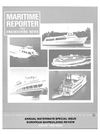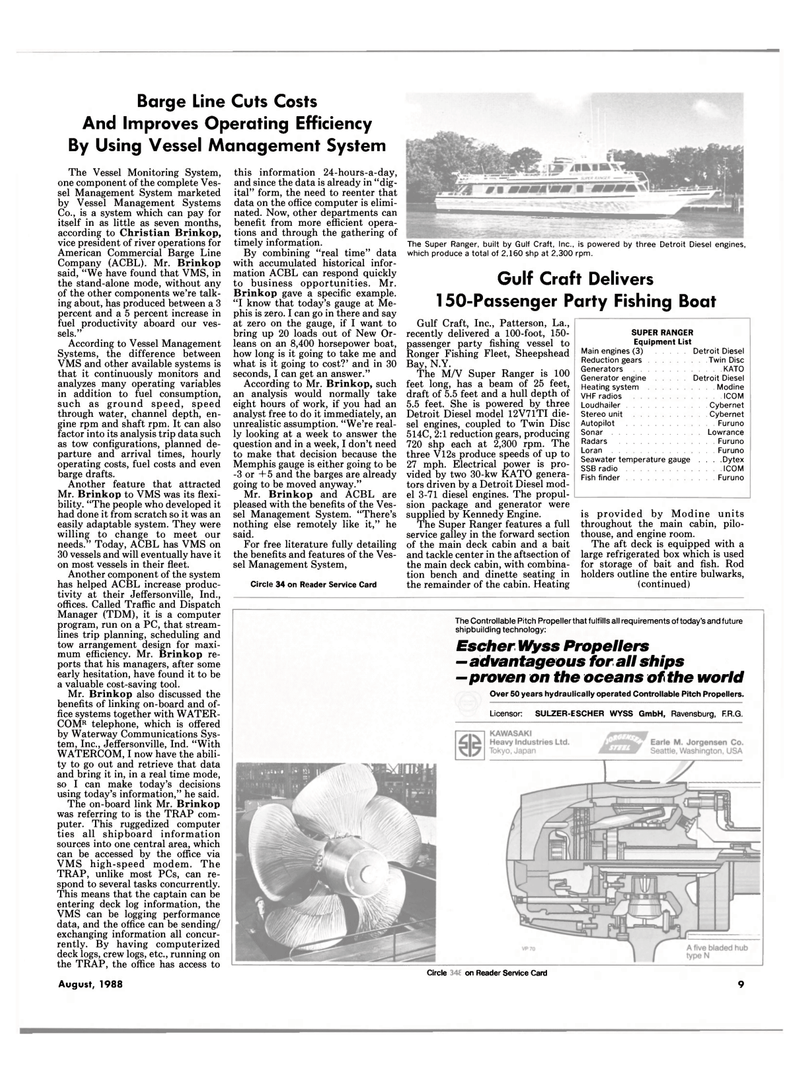
Page 7: of Maritime Reporter Magazine (August 1988)
Read this page in Pdf, Flash or Html5 edition of August 1988 Maritime Reporter Magazine
Barge Line Cuts Costs
And Improves Operating Efficiency
By Using Vessel Management System
The Super Ranger, built by Gulf Craft, Inc., is powered by three Detroit Diesel engines, which produce a total of 2,160 shp at 2,300 rpm.
Gulf Craft Delivers 150-Passenger Party Fishing Boat
SUPER RANGER
Equipment List
Main engines (3) Detroit Diesel
Reduction gears . .Twin Disc
Generators . . . .KATO
Generator engine Detroit Diesel
Heating system . . . Modine
VHF radios . . . .ICOM
Loudhailer . . Cybernet
Stereo unit . . Cybernet
Autopilot . . . Furuno
Sonar Lowrance
Radars . . . Furuno
Loran . . . Furuno
Seawater temperature gauge . . . Dytex
SSB radio . . . .ICOM
Fish finder . . . Furuno
The Vessel Monitoring System, one component of the complete Ves- sel Management System marketed by Vessel Management Systems
Co., is a system which can pay for itself in as little as seven months, according to Christian Brinkop, vice president of river operations for
American Commercial Barge Line
Company (ACBL). Mr. Brinkop said, "We have found that VMS, in the stand-alone mode, without any of the other components we're talk- ing about, has produced between a 3 percent and a 5 percent increase in fuel productivity aboard our ves- sels."
According to Vessel Management
Systems, the difference between
VMS and other available systems is that it continuously monitors and analyzes many operating variables in addition to fuel consumption, such as ground speed, speed through water, channel depth, en- gine rpm and shaft rpm. It can also factor into its analysis trip data such as tow configurations, planned de- parture and arrival times, hourly operating costs, fuel costs and even barge drafts.
Another feature that attracted
Mr. Brinkop to VMS was its flexi- bility. "The people who developed it had done it from scratch so it was an easily adaptable system. They were willing to change to meet our needs." Today, ACBL has VMS on 30 vessels and will eventually have it on most vessels in their fleet.
Another component of the system has helped ACBL increase produc- tivity at their Jeffersonville, Ind., offices. Called Traffic and Dispatch
Manager (TDM), it is a computer program, run on a PC, that stream- lines trip planning, scheduling and tow arrangement design for maxi- mum efficiency. Mr. Brinkop re- ports that his managers, after some early hesitation, have found it to be a valuable cost-saving tool.
Mr. Brinkop also discussed the benefits of linking on-board and of- fice systems together with WATER-
COMR telephone, which is offered by Waterway Communications Sys- tem, Inc., Jeffersonville, Ind. "With
WATERCOM, I now have the abili- ty to go out and retrieve that data and bring it in, in a real time mode, so I can make today's decisions using today's information," he said.
The on-board link Mr. Brinkop was referring to is the TRAP com- puter. This ruggedized computer ties all shipboard information sources into one central area, which can be accessed by the office via
VMS high-speed modem. The
TRAP, unlike most PCs, can re- spond to several tasks concurrently.
This means that the captain can be entering deck log information, the
VMS can be logging performance data, and the office can be sending/ exchanging information all concur- rently. By having computerized deck logs, crew logs, etc., running on the TRAP, the office has access to this information 24-hours-a-day, and since the data is already in "dig- ital" form, the need to reenter that data on the office computer is elimi- nated. Now, other departments can benefit from more efficient opera- tions and through the gathering of timely information.
By combining "real time" data with accumulated historical infor- mation ACBL can respond quickly to business opportunities. Mr.
Brinkop gave a specific example. "I know that today's gauge at Me- phis is zero. I can go in there and say at zero on the gauge, if I want to bring up 20 loads out of New Or- leans on an 8,400 horsepower boat, how long is it going to take me and what is it going to cost?' and in 30 seconds, I can get an answer."
According to Mr. Brinkop, such an analysis would normally take eight hours of work, if you had an analyst free to do it immediately, an unrealistic assumption. "We're real- ly looking at a week to answer the question and in a week, I don't need to make that decision because the
Memphis gauge is either going to be -3 or +5 and the barges are already going to be moved anyway."
Mr. Brinkop and ACBL are pleased with the benefits of the Ves- sel Management System. "There's nothing else remotely like it," he said.
For free literature fully detailing the benefits and features of the Ves- sel Management System,
Circle 34 on Reader Service Card
Gulf Craft, Inc., Patterson, La., recently delivered a 100-foot, 150- passenger party fishing vessel to
Ronger Fishing Fleet, Sheepshead
Bay, N.Y.
The M/V Super Ranger is 100 feet long, has a beam of 25 feet, draft of 5.5 feet and a hull depth of 5.5 feet. She is powered by three
Detroit Diesel model 12V71TI die- sel engines, coupled to Twin Disc 514C, 2:1 reduction gears, producing 720 shp each at 2,300 rpm. The three V12s produce speeds of up to 27 mph. Electrical power is pro- vided by two 30-kw KATO genera- tors driven by a Detroit Diesel mod- el 3-71 diesel engines. The propul- sion package and generator were supplied by Kennedy Engine.
The Super Ranger features a full service galley in the forward section of the main deck cabin and a bait and tackle center in the aftsection of the main deck cabin, with combina- tion bench and dinette seating in the remainder of the cabin. Heating is provided by Modine units throughout the main cabin, pilo- thouse, and engine room.
The aft deck is equipped with a large refrigerated box which is used for storage of bait and fish. Rod holders outline the entire bulwarks, (continued)
The Controllable Pitch Propeller that fulfills all requirements of today's and future shipbuilding technology:
Escher Wyss Propellers —advantageous for all ships —proven on the oceans of the world
Over 50 years hydraulically operated Controllable Pitch Propellers.
Licensor: SULZER-ESCHER WYSS GmbH, Ravensburg, F.R.G.
Circle 121 on Reader Service Card
August, 1988 9

 6
6

 8
8
